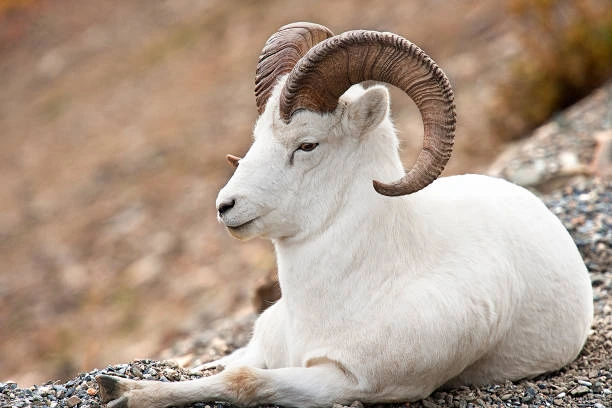Table of Contents
Scientific Classification
| Kingdom | Animalia |
| Phylum | Chordata |
| Class | Mammalia |
| Order | Artiodactyla |
| Family | Bovidae |
| Genus | Ovis |
| Species | O. dalli |
| Scientific Name | Ovis dalli |
1. Description
The Dall sheep is quite the iconic alpine creature. You can easily spot them thanks to their striking white coats and the impressive, spiraled horns of the males. These medium-sized wild sheep are fantastic climbers, perfectly adapted to the rugged, rocky mountains they call home. The rams, or males, sport thick, curling horns that can weigh up to 30 pounds, while the ewes, the females, have shorter and more slender horns. Adult males typically tip the scales at around 160 to 250 pounds, whereas females usually weigh between 110 and 150 pounds.
Their pristine white coats help them blend seamlessly into the snowy mountain landscape, and they even reflect sunlight on those bright alpine days. During the summer months, their fur thins out but remains white, allowing them to stay camouflaged in their environment.
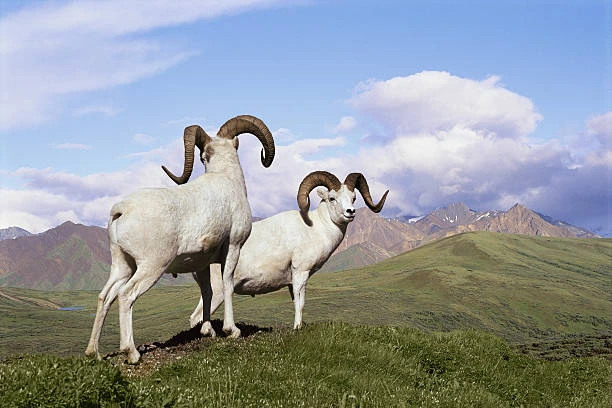
2. Distribution
Dall sheep are a fascinating species native to the northwestern part of North America. You can spot them in places like Alaska, the Yukon, and the western Northwest Territories of Canada. They’re often seen roaming around Denali National Park and the stunning Wrangell-St. Elias mountains.
There are two main subspecies: the Dall sheep (Ovis dalli dalli), which sports a striking pure white coat, and the Stone sheep (Ovis dalli stonei), known for its more grayish hue and found further south in British Columbia.
3. Habitat
Dall sheep are true mountain dwellers, thriving at high elevations in subarctic and alpine regions. You can often catch a glimpse of them above the tree line, navigating the rugged, rocky terrain that offers them great visibility and a safe escape from predators.
In the winter, they tend to favor south-facing slopes, which allows them to soak up more sunlight and avoid deep snow. When summer rolls around, they venture even higher up the mountains to graze, steering clear of the heat and pesky insects. With their sturdy hooves and sharp eyesight, they’re perfectly adapted to tackle the steep and uneven landscapes they call home.
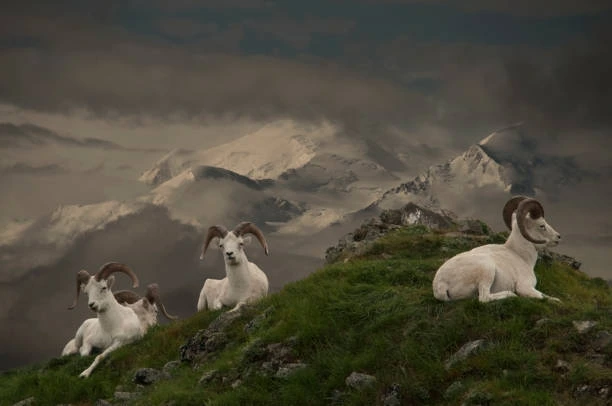
4. Diet
Dall sheep are herbivores, and their diet mainly consists of grasses, sedges, lichens, and mosses. What they eat changes with the seasons; during summer, they enjoy a wider range of plants, while winter makes finding food a bit of a challenge. In those colder months, they rely on dried grass and lichen, often digging through the snow or searching in windy areas to uncover their meals.
Salt and minerals play a vital role in their nutrition, which is why Dall sheep frequently visit natural mineral licks. These licks not only help with digestion but also contribute to the health of their horns and bones.
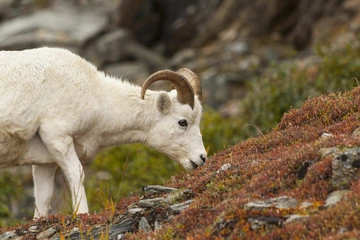
5. Behavior
Dall sheep are quite the social creatures! When it’s not mating season, you’ll often find the rams hanging out in bachelor groups, while the ewes and their little ones stick together in maternal groups. Their social structure is pretty stable, with clear hierarchies that depend on age and the size of their horns.
These sheep are diurnal, which means they’re most active during the day, especially in the early morning and late afternoon. They spend their time grazing, resting, or moving between their favorite feeding spots and safe havens. Their agility and strong instinct to flee are essential for dodging predators.
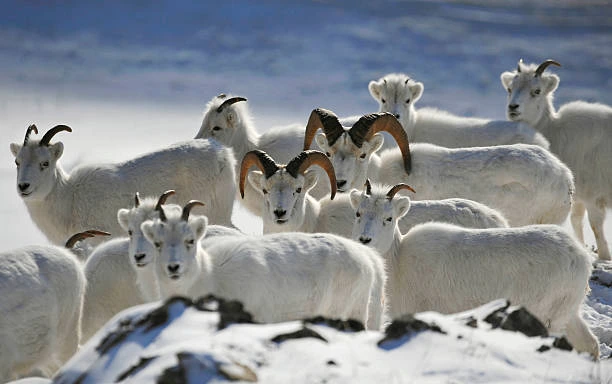
6. Lifespan
When it comes to lifespan, Dall sheep in the wild typically live between 12 to 16 years, but on average, you can expect them to reach around 8 to 10 years. Unfortunately, lambs and older sheep are particularly vulnerable, facing higher mortality rates. This risk is especially pronounced during harsh winters or when they become targets for predators.
7. Reproduction and Lifecycle
When it comes to reproduction and lifecycle, ewes typically reach sexual maturity around 2.5 to 3 years of age. Rams, on the other hand, often don’t start breeding successfully until they’re between 6 and 8 years old, which is when they really start to compete for mates. The reproductive cycle kicks off during the rut, which usually occurs from late November to early December.
After mating, ewes have a gestation period of about 170 days. They usually give birth to a single lamb in late May or early June. These little ones are precocial, meaning they’re born with a coat of fur and can stand up shortly after birth. They’re also able to follow their mothers within just a few hours. To keep their lambs safe from predators, ewes often look for secluded, rocky ledges to give birth.
For the first few months, lambs nurse and gradually start to graze. By autumn, they blend in well with the maternal group, but they still rely on their mothers during their first winter.
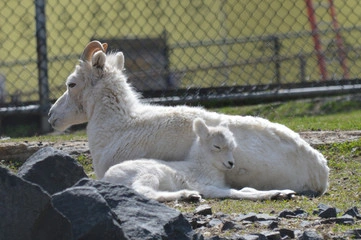
8. Predators
Dall sheep face a variety of predators in their natural habitat. Among these are wolves, coyotes, golden eagles, and grizzly bears. Golden eagles are particularly dangerous for lambs, as they can swoop down from above and snatch them right off the cliffs.
When it comes to adult sheep, wolves and bears present a more serious threat. However, these clever animals have a knack for escaping into rocky, hard-to-reach areas, which gives them a significant advantage.
9. Adaptations
- Dall sheep have a variety of physical and behavioral traits that make them perfectly adapted to life in the mountains:
- Hooves: Their unique split hooves, equipped with rough footpads, give them fantastic traction on rocky terrain.
- Coloration: The striking white coat acts as a natural camouflage against the snow.
- Keen Senses: With their sharp eyesight, they can spot predators from far away.
- Thermal Regulation: Their thick fur and specialized metabolism help them retain heat during the chilly winter months.
- Horns grow annually, serving as a display of dominance and playing a key role in battles during the rutting season.
10. Conservation Status
According to the IUCN Red List, the Dall sheep is currently classified as “Least Concern.” Their populations remain stable, particularly in protected areas like national parks and reserves.
However, they still face threats from habitat disruption, climate change, and diseases that can be transmitted from domestic sheep. It’s crucial to keep monitoring their numbers and to focus on habitat conservation to ensure their populations continue to thrive.
11. Nest
Dall sheep have a unique approach when it comes to giving birth—unlike birds or rodents, they don’t build nests. Instead, ewes carefully select safe spots, often opting for rocky outcrops or cliff ledges that are tough to access. This strategy helps keep their little lambs out of harm’s way. These chosen birthing locations not only provide shelter but also allow for a quick getaway if any predators come sniffing around.
12. Mating Season
Mating season, often referred to as the rut, happens from late November to early December. During this time, rams engage in intense head-butting contests. This display of strength is all about establishing dominance and securing breeding rights. The clashes can get pretty wild, with males charging at each other and crashing their horns together, showcasing their power and endurance.
Ewes that are in estrus will typically choose the most dominant ram, and mating usually follows soon after. Once the breeding season wraps up, rams head back to their bachelor groups.
13. Breeding
Breeding is a fascinating process that follows seasonal cycles, heavily influenced by the environment. Once mating is successful, the gestation period lasts about 5.5 months. As lambing time approaches, ewes tend to separate themselves from the rest of the herd.
Typically, lambs are born in the spring, which is perfect timing since more food becomes available then. While it’s common for ewes to have a single lamb, twins can happen, though they’re quite rare. In those crucial early weeks, maternal care is essential. The ewe provides both nourishment and protection to her little one.
14. Fascinating Facts
Horn Rings: The horns of rams have unique growth rings that can help us figure out their age.
Silent Climbers: Dall sheep, despite their size, are surprisingly quiet as they navigate rocky terrains.
Sheep Salt Parties: These animals often trek long distances just to find salt licks, which are essential for their diet.
Survivalists: Lambs are born with the ability to scale steep cliffs just hours after they arrive in the world.
Record Holders: Some rams boast horns that can exceed 40 inches in length.
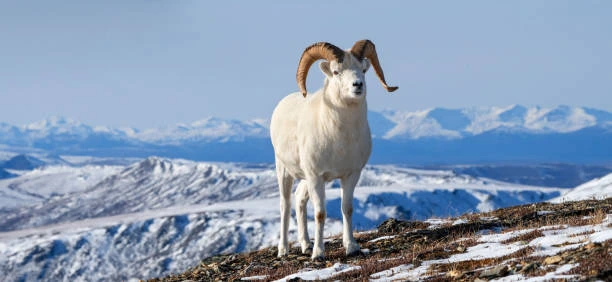
The Dall sheep is a true symbol of the alpine wilderness. They are tough, nimble, and perfectly adapted to survive in some of the harshest environments on the planet. By learning about their life cycle, behavior, and habitat, we gain insight into how they embody the spirit of wild mountain ecosystems.

